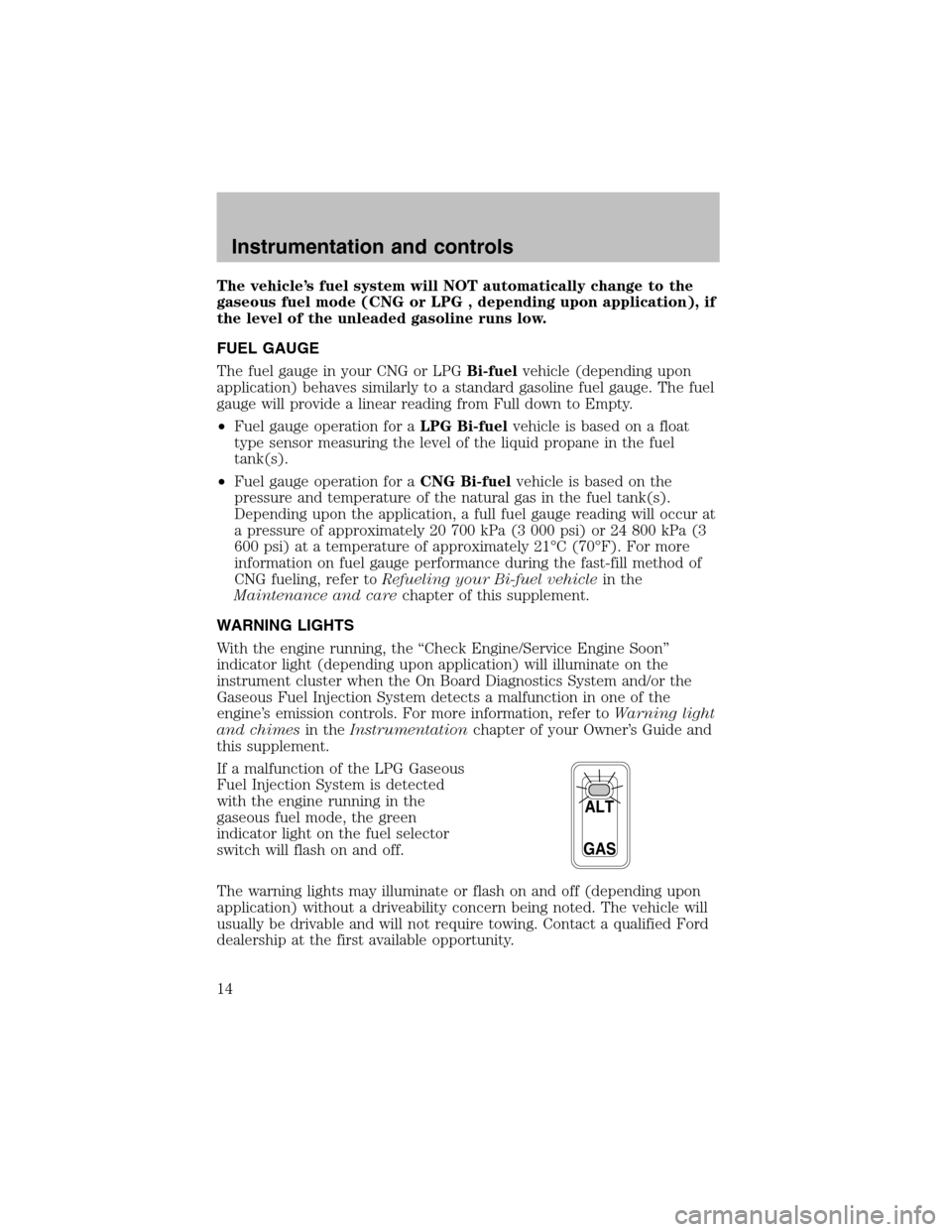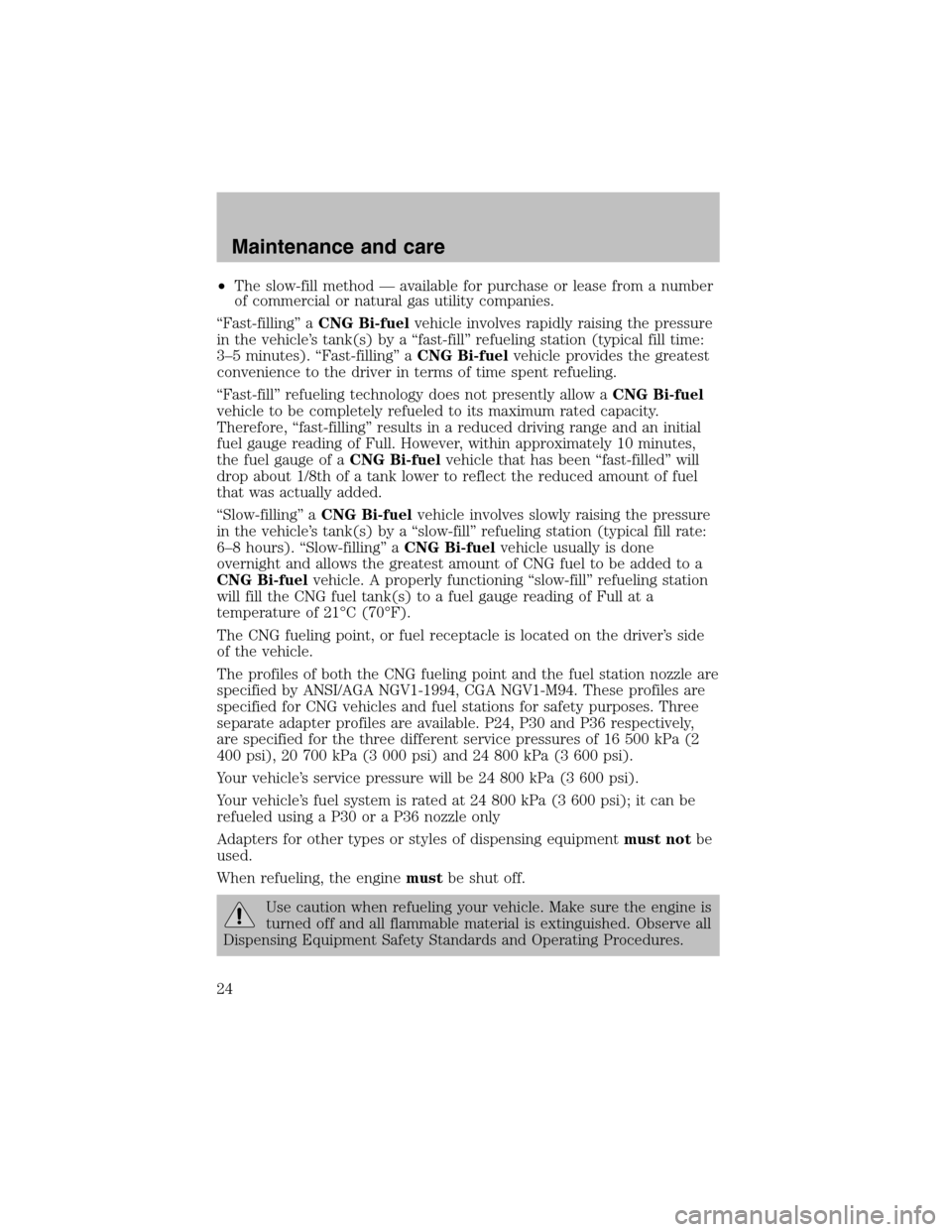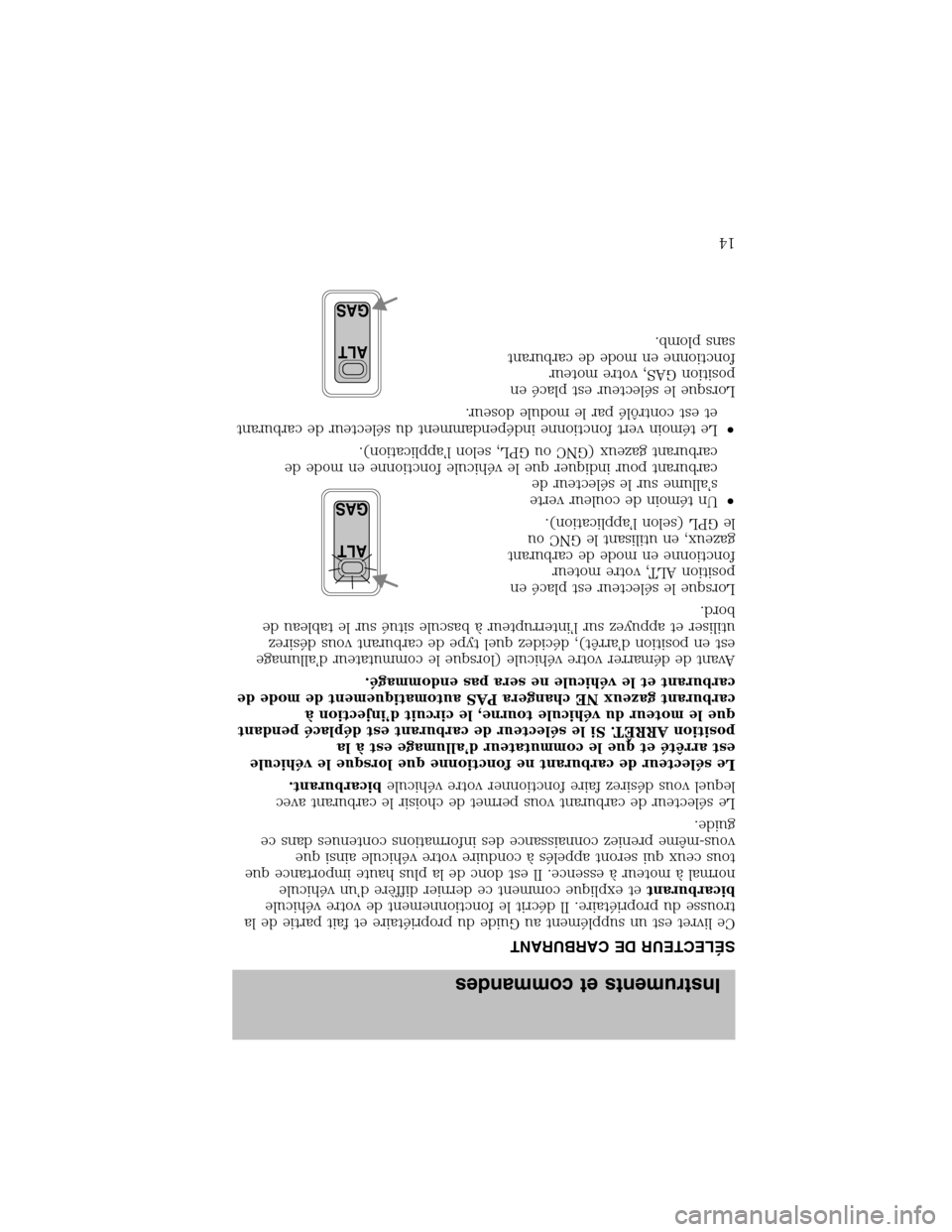gas type FORD F150 2003 10.G Bi Fuel Supplement Manual
[x] Cancel search | Manufacturer: FORD, Model Year: 2003, Model line: F150, Model: FORD F150 2003 10.GPages: 72, PDF Size: 4.51 MB
Page 2 of 72

ABOUT THIS SUPPLEMENT
This booklet supplements your Owner’s Guide and is part of the owner’s
portfolio. It describes the operation of yourBi-fuelvehicle and how it
differs from a standard gasoline powered vehicle. Therefore it is very
important that you read this guide and thoroughly familiarize yourself
and others operating the vehicle with this information.
Some of the information in this supplement replaces certain instructions
in the Owner’s Guide. Please read this supplement carefully and
completely. Refer to the Owner’s Guide for complete vehicle information.
WARNINGS
Warnings remind you to be especially careful in those areas of the
vehicle where carelessness can cause damage to your vehicle or possible
personal injury to yourself, your passengers or others. Please read all
warnings carefully.
•Warnings are identified by this symbol
ABOUT THE WARRANTIES
The normal vehicle warranties will apply to yourBi-fuelvehicle. For
further information, refer to your Warranty Information Booklet in the
owner’s portfolio.
Specified maintenance procedures must be followed. Repairs must be
made by trained personnel.
It is important that yourBi-fuelvehicle be properly maintained by
qualified Ford service technicians. If a concern occurs, it is important
that properly trained personnel diagnose and repair the cause. If the
concern relates to the fuel system, proper part replacement is imperative
to keep your vehicle operating correctly.Bi-fuelcomponents and
standard fuel components are not interchangeable. If yourBi-fuel
vehicle is not maintained in accordance with approved service
procedures, damage may occur and your warranty may be invalidated.
GASEOUS FUEL INJECTION
YourBi-fuelvehicle is equipped with two fuel injection systems, an
unleaded gasoline fuel system and a gaseous fuel injection system.
Two types of gaseous fuel injection systems are available:
•Compressed Natural Gas (CNG)
•Liquefied Petroleum Gas (LPG)
Introduction
2
Page 5 of 72

Use caution when servicing or maintaining any of the components of
your Gaseous Fuel Injection System.
Do not modify the gaseous fuel injection system configuration or
components. Do not replace the gaseous fuel injection system
components with parts not designed for use with your Bi-fuel vehicle.
Components designed for use in your CNG or LPG Bi-fuel vehicle
consist of special materials and are calibrated especially for your
vehicle. Failure to use the correct components may cause damage to
the engine and fuel system or possible personal injury.
Service to the gaseous fuel injection system components must be
conducted only at qualified dealerships by qualified service
technicians. Failure to do so may cause damage to the engine and fuel
system components or possible personal injury.
Any modification to your Gaseous Fuel Injection System voids the Ford
New Vehicle Limited Warranty.
Do not use liquefied natural gas (LNG) or a CNG that is derived
from a process such as flashing (heating LNG). Failure to use the
correct type of fuel may cause damage to the engine and fuel
system components.
If the vehicle is involved in an accident or fire that damages any
portion of the gaseous fuel injection system, the damaged
components MUST be replaced and the complete system tested by
a qualified service technician before the vehicle is operated
again.
If yourBi-fuelvehicle is to be painted, the CNG or propane fuel tank(s)
and fuel lines must be emptied before the vehicle is placed in a heated
room, known as a“paint oven”, for the new paint to cure. These“paint
ovens”typically operate at temperatures up to 60°C (140°F). The high
temperatures in the“paint oven”could cause the fuel in the fuel tanks to
expand, which may cause an overpressure condition within the fuel tanks
that can be hazardous to personal safety and property. Contact your
qualified Ford dealership for assistance.
Introduction
5
Page 14 of 72

The vehicle’s fuel system will NOT automatically change to the
gaseous fuel mode (CNG or LPG , depending upon application), if
the level of the unleaded gasoline runs low.
FUEL GAUGE
The fuel gauge in your CNG or LPGBi-fuelvehicle (depending upon
application) behaves similarly to a standard gasoline fuel gauge. The fuel
gauge will provide a linear reading from Full down to Empty.
•Fuel gauge operation for aLPG Bi-fuelvehicle is based on a float
type sensor measuring the level of the liquid propane in the fuel
tank(s).
•Fuel gauge operation for aCNG Bi-fuelvehicle is based on the
pressure and temperature of the natural gas in the fuel tank(s).
Depending upon the application, a full fuel gauge reading will occur at
a pressure of approximately 20 700 kPa (3 000 psi) or 24 800 kPa (3
600 psi) at a temperature of approximately 21°C (70°F). For more
information on fuel gauge performance during the fast-fill method of
CNG fueling, refer toRefueling your Bi-fuel vehiclein the
Maintenance and carechapter of this supplement.
WARNING LIGHTS
With the engine running, the“Check Engine/Service Engine Soon”
indicator light (depending upon application) will illuminate on the
instrument cluster when the On Board Diagnostics System and/or the
Gaseous Fuel Injection System detects a malfunction in one of the
engine’s emission controls. For more information, refer toWarning light
and chimesin theInstrumentationchapter of your Owner’s Guide and
this supplement.
If a malfunction of the LPG Gaseous
Fuel Injection System is detected
with the engine running in the
gaseous fuel mode, the green
indicator light on the fuel selector
switch will flash on and off.
The warning lights may illuminate or flash on and off (depending upon
application) without a driveability concern being noted. The vehicle will
usually be drivable and will not require towing. Contact a qualified Ford
dealership at the first available opportunity.
GASALT
Instrumentation and controls
14
Page 24 of 72

•The slow-fill method—available for purchase or lease from a number
of commercial or natural gas utility companies.
“Fast-filling”aCNG Bi-fuelvehicle involves rapidly raising the pressure
in the vehicle’s tank(s) by a“fast-fill”refueling station (typical fill time:
3–5 minutes).“Fast-filling”aCNG Bi-fuelvehicle provides the greatest
convenience to the driver in terms of time spent refueling.
“Fast-fill”refueling technology does not presently allow aCNG Bi-fuel
vehicle to be completely refueled to its maximum rated capacity.
Therefore,“fast-filling”results in a reduced driving range and an initial
fuel gauge reading of Full. However, within approximately 10 minutes,
the fuel gauge of aCNG Bi-fuelvehicle that has been“fast-filled”will
drop about 1/8th of a tank lower to reflect the reduced amount of fuel
that was actually added.
“Slow-filling”aCNG Bi-fuelvehicle involves slowly raising the pressure
in the vehicle’s tank(s) by a“slow-fill”refueling station (typical fill rate:
6–8 hours).“Slow-filling”aCNG Bi-fuelvehicle usually is done
overnight and allows the greatest amount of CNG fuel to be added to a
CNG Bi-fuelvehicle. A properly functioning“slow-fill”refueling station
will fill the CNG fuel tank(s) to a fuel gauge reading of Full at a
temperature of 21°C (70°F).
The CNG fueling point, or fuel receptacle is located on the driver’s side
of the vehicle.
The profiles of both the CNG fueling point and the fuel station nozzle are
specified by ANSI/AGA NGV1-1994, CGA NGV1-M94. These profiles are
specified for CNG vehicles and fuel stations for safety purposes. Three
separate adapter profiles are available. P24, P30 and P36 respectively,
are specified for the three different service pressures of 16 500 kPa (2
400 psi), 20 700 kPa (3 000 psi) and 24 800 kPa (3 600 psi).
Your vehicle’s service pressure will be 24 800 kPa (3 600 psi).
Your vehicle’s fuel system is rated at 24 800 kPa (3 600 psi); it can be
refueled using a P30 or a P36 nozzle only
Adapters for other types or styles of dispensing equipmentmust notbe
used.
When refueling, the enginemustbe shut off.
Use caution when refueling your vehicle. Make sure the engine is
turned off and all flammable material is extinguished. Observe all
Dispensing Equipment Safety Standards and Operating Procedures.
Maintenance and care
24
Page 29 of 72

LPG refill capacities—gasoline equivalent
F-150
Single in-bed tank Dual in-bed tanks
127.7L (33.7 gallons) 107.5L (28.4 gallons) - Regular
Cab
97.0L (25.6 gallons) - SuperCab
FUEL DISPENSING EQUIPMENT
Most dispensing equipment will have a digital indicator that displays the
cost and amount of fuel delivered to your vehicle. Fuel delivery to the
vehicle is stopped when the amount of fuel stored on the vehicle reaches
the maximum refill pressure or quantity (depending upon application).
Certain noises can be expected during the refueling process and may
vary depending on the type of fuel dispensing equipment and your
proximity to the fuel compression and storage equipment. At the
beginning of refueling you might hear the rushing noise of gas entering
the vehicle through the station hose and tubing. At the end of refueling,
the fuel receptacle on the vehicle may make a high pitched noise or
chatter. This is another indication that refueling is nearly complete. Also,
the station dispensing equipment compressor may turn on at any time
during the refueling process.
REFUELING STATIONS
To obtain a directory of all CNG refueling stations in the United States,
contact the American Gas Association (AGA) at 1–703–841–8400. In
Canada, contact Union Gas at 1–800–265–5277. For information on LPG
refueling stations, contact the U.S Dept of Energy Altertnative Fuels
Data Center at 1-800-423-1DOE (423-1363).
TANK INSPECTION AND REPLACEMENT
The fuel tank(s) of the Gaseous Fuel Injection System (CNG or LPG,
depending upon application) must be inspected and tested on a regular
basis to verify the condition of the tank(s).
Refer to your scheduled maintenance guide in your owner’s portfolio for
fuel tank inspection intervals.
Inspection and testing of the fuel tank(s) must be done by a qualified
Ford service technician, or by the local authority governing the
enforcement of gaseous fuel regulations in the jurisdiction of which you
refuel.
Maintenance and care
29
Page 59 of 72

SÉLECTEUR DE CARBURANT
Ce livret est un supplément au Guide du propriétaire et fait partie de la
trousse du propriétaire. Il décrit le fonctionnement de votre véhicule
bicarburantet explique comment ce dernier diffère d’un véhicule
normalàmoteuràessence. Il est donc de la plus haute importance que
tous ceux qui seront appelésàconduire votre véhicule ainsi que
vous-même preniez connaissance des informations contenues dans ce
guide.
Le sélecteur de carburant vous permet de choisir le carburant avec
lequel vous désirez faire fonctionner votre véhiculebicarburant.
Le sélecteur de carburant ne fonctionne que lorsque le véhicule
est arrêtéet que le commutateur d’allumage estàla
position ARRÊT. Si le sélecteur de carburant est déplacépendant
que le moteur du véhicule tourne, le circuit d’injectionà
carburant gazeux NE changera PAS automatiquement de mode de
carburant et le véhicule ne sera pas endommagé.
Avant de démarrer votre véhicule (lorsque le commutateur d’allumage
est en position d’arrêt), décidez quel type de carburant vous désirez
utiliser et appuyez sur l’interrupteuràbascule situésur le tableau de
bord.
Lorsque le sélecteur est placéen
position ALT, votre moteur
fonctionne en mode de carburant
gazeux, en utilisant le GNC ou
le GPL (selon l’application).
•Un témoin de couleur verte
s’allume sur le sélecteur de
carburant pour indiquer que le véhicule fonctionne en mode de
carburant gazeux (GNC ou GPL, selon l’application).
•Le témoin vert fonctionne indépendamment du sélecteur de carburant
et est contrôlépar le module doseur.
Lorsque le sélecteur est placéen
position GAS, votre moteur
fonctionne en mode de carburant
sans plomb.
ALT
GAS
ALT
GAS
Instruments et commandes
14
Page 70 of 72

Deux types de systèmes d’injectionàcarburant gazeux sont disponibles :
•gaz naturel comprimé(GNC);
•gaz de pétrole liquéfié(GPL).
Les deux systèmes d’injectionàcarburant gazeux disponibles
fonctionnent d’une façon assez similaire. Toutefois, des différences au
niveau des pressions de fonctionnement et des propriétés des carburants
gazeux existent et il estimportantde connaître la nature du système
que vous utilisez.
Si vous n’êtes pas certain de connaître la nature du circuit d’alimentation
présent dans votre véhicule, communiquez avec votre concessionnaire.
Votre nouveau circuit d’injectionàcarburant gazeux est le fruit de
plusieurs années de recherches et d’expérience technique. Il utilise les
plus récents dispositifsélectroniquesàsemi-conducteurs afin de
procurer d’excellentes conditions de comportement du moteur, de
contrôle desémissions et d’économie de carburant.
Gaz naturel comprimé(GNC)
Le gaz naturel comprimé(GNC) est un mélange d’hydrocarbures gazeux
àhaute concentration de méthane qui est emmagasinésous haute
pression.
Des réserves de gaz naturel en abondance au Canada et auxÉtats-Unis
permettent d’utiliser le gaz naturel en tant que carburantéconomique.
Le gaz naturel est un carburantàcombustion propre, ce qui en fait un
carburant toutàfait convenable en ce qui a trait aux normes d’émissions
automobiles.
Le circuit d’alimentation au gaz naturel compriméest calibréàune
pression de 24 800 kPa (3 600 lb/po
2)à21°C (70°F). Le calibrage de
pression du circuit d’alimentation de GNC est spécifiésur uneétiquette
apposéeprès du point de prise de carburant de GNC.
Introduction
3